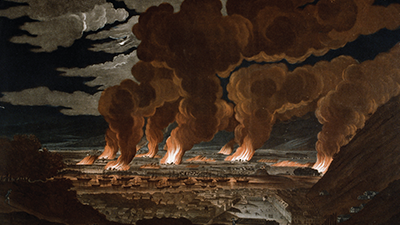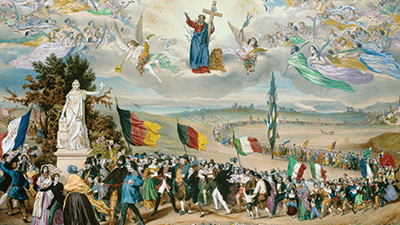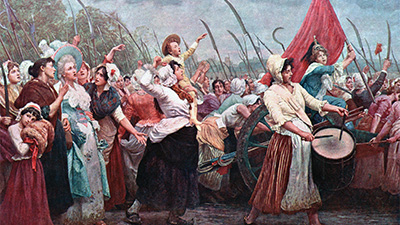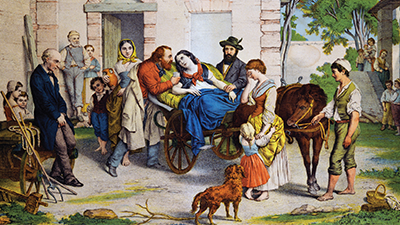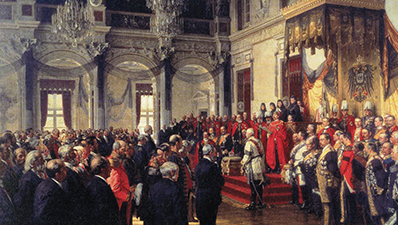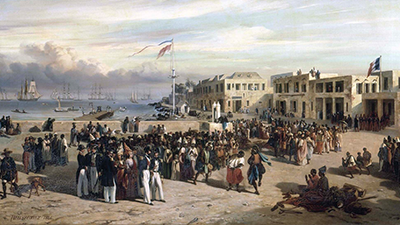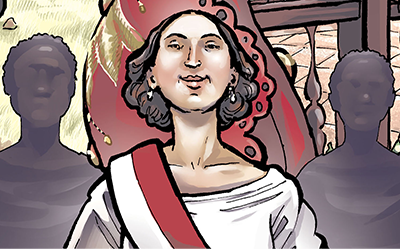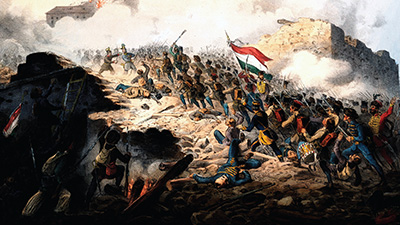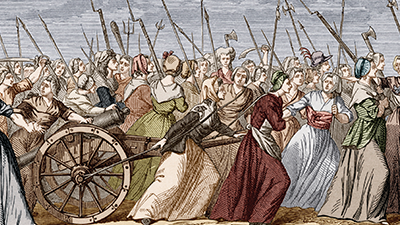Nationalism and Revolutions in the Period from c. 1750-1900 CE
Teacher Resources
Driving Question: How did different parts of the world experience the revolutionary transformations that occurred from c. 1750 to 1900 CE?
Revolutionary ideas came from a desire to change how society and government were structured. These ideas challenged old traditions and called for fairness and equality. Enlightenment thinkers helped shape these beliefs by promoting rights of the individual and the notion that power came from the people. Combined with economic struggles and political complaints, these ideas led to movements for more just and inclusive societies.
Learning Objectives
- Explain the causes and effects of the various revolutions in the period from 1750 to 1900.
- Use graphic biographies to support, extend, or challenge the overarching narratives from this period.
- Analyze primary source documents to evaluate the intellectual and ideological causes of political revolutions from c. 1750 to 1900 CE.
Vocab Terms:
- aristocracy
- autonomy
- bourgeoisie
- ethnic nationalism
- liberal
- radical
- republic
Opener: Nationalism and Revolutions
To teach this lesson step, refer to page 3 of the Lesson 5.2 Teaching Guide.
Looking for fresh ways to teach new vocabulary? Look no further than the OER Project Vocabulary Guide.
Revolutions are a key concept in this lesson. What is a revolution? And how similar is it to evolution?
The Haitian Revolution
To teach this lesson step, refer to page 4 of the Lesson 5.2 Teaching Guide.
Sometimes a revolution is just the beginning of real change. Was this the case with the Haitian Revolution? This video may provide some answers.
-
Guiding Questions
-
Before you watch
Preview the questions below, and then review the transcript.
While you watch
Look for answers to these questions:
- Who made up the social classes in Saint Domingue, and why was this social pyramid unstable?
- What was life like for an enslaved person in Saint Domingue?
- What was the goal of the revolutionaries in the revolution’s early days?
- Who was Toussaint Louverture, and why did he fight first for the Spanish and then for the French?
- How did enslaved people learn about revolutionary ideas?
- In what ways did Haiti’s struggle continue beyond independence?
After you watch
Respond to the following questions:
- Do you think the Haitian Revolution was the most radical of the Atlantic revolutions? What evidence from the video supports your view?
Key Ideas
Causation: Recipe for a Revolution
To teach this lesson step, refer to page 5 of the Lesson 5.2 Teaching Guide.
Ready to cook up a revolution? See Recipe for a Revolution Materials from other OER Project teachers.
What are the ingredients for a revolution? A dash of discontent? A sprinkle of disruptive events? The materials below may help you cook up some ideas about the causes of revolution!
-
Guiding Questions
-
Before you read
Preview the questions below, and then skim the article. Be sure to look at the section headings and any images.
While you read
Look for answers to these questions:
- What first sparked the American Revolution?
- What was the Third Estate?
- What did the American Declaration of Independence and the French Declaration of the Rights of Man have in common? How did they differ?
- How did the French Revolution impact Saint Domingue? What were some other causes of the Haitian revolution?
- What groups took power in South America, and how was this different from the group that took power in Saint Domingue?
After you read
Respond to the following questions:
- To what extent does this article explain the causes and effects of the various revolutions in the period from 1750 to 1900?
- How revolutionary were each of the revolutions described in this article? What changed? What didn’t?
Revolutionary Women
To teach this lesson step, refer to page 10 of the Lesson 5.2 Teaching Guide.
Before starting the Revolutionary Women activity, check out this blog post for experienced teacher’s suggestions for modification.
What makes someone a revolutionary? You will research some women who exhibited revolutionary behavior—and even create a public relations campaign for one!
Nationalism
To teach this lesson step, refer to page 13 of the Lesson 5.2 Teaching Guide.
Is nationalism a good or bad thing? The answer is probably more nuanced than a binary choice might suggest. This video will help you clarify your ideas about the effects of nationalism.
-
Guiding Questions
-
Before you watch
Before you watch the video, it’s a good idea to open and skim the video transcript. And always read the questions below so you know what to look and listen for as you watch!
While you watch
Look for answers to these questions:
- How does this video define nationalism?
- What did Benedict Anderson mean when he called the nation an “imagined political community”?
- Where did nationalism begin and how did it spread?
- How did nationalism contribute to the extreme violence of the twentieth century?
- How do nationalists construct ideas about their nation?
- What is some evidence referenced in this video as to whether nationalism is good or bad?
After you watch
Respond to the following questions:
- The opening quote of this video is by the American novelist Kurt Vonnegut. In the quote, Vonnegut warns that “We are what we pretend to be, so we must be careful about what we pretend to be.” Why do you think this quote was included in this video?
- This video is pretty clear about nationalism’s impacts on communities. What are some ways that nationalism affected networks and production and distribution?
Key Ideas
The World Revolution of 1848
To teach this lesson step, refer to page 14 of the Lesson 5.2 Teaching Guide.
Colonialism and industrialization benefitted a few countries but created a massive amount of conflict as well. What led to multiple revolutions during this era of increased global connection?
-
Guiding Questions
-
Before you read
Preview the questions below, and then skim the article. Be sure to look at the section headings and any images.
While you read
Look for answers to these questions:
- What caused the revolutions of 1848 in Europe?
- Why did the revolutions of 1848 fail?
- What effects did the Taiping Revolution and the Great Revolt of 1857 have on British power in Asia?
- Why does the author suggest that all these revolutions happened around the same time?
- From Europe to China, what was the common effect of the failed revolutions from 1848 to 1865?
After you read
Respond to the following questions:
- To what extent does this article provide evidence to explain the intellectual and ideological context in which revolutions swept the world from 1750 to 1900?
- All the revolutions mentioned in this article failed. However, thinking back to your discussions from the last lesson, how revolutionary would the revolutions of 1848, the Taiping Revolution, and the Indian Rebellion of 1857 have been, if they had succeeded?
- The 1848 revolutions were largely driven by two questions: a governance question that mostly the middle-class liberals pushed (who gets to participate in ruling?) and an economic question that mostly working-class radicals pushed (who gets the profit from industrialization?) Were either of these questions resolved by these revolutions?
Source Collection: Revolutions
To teach this lesson step, refer to page 16 of the Lesson 5.2 Teaching Guide.
Looking for more ways to support your students in sourcing? The Sourcing Topic Page has all OER Project sourcing materials in one location.
How did the revolutions of this era impact the themes of governance, economic systems, social interactions, and cultural developments? The primary sources in this collection will help you formulate a response to this question. We recommend you use the Quick-Sourcing Tool to complete this exercise.
Closer: Nationalism and Revolutions
To teach this lesson step, refer to page 16 of the Lesson 5.2 Teaching Guide.
Want a teacher-tested tool for building arguments? Check out the Making Claims Worksheets thread in the Community Forum.
It’s time to take the knowledge you have acquired and make some claims about history!
Calls for National Unification or Liberation
To teach this lesson step, refer to page 17 of the Lesson 5.2 Teaching Guide.
From Italy to Germany, to West Africa and Latin America, the resources below offer a global look at calls for national unification or liberation during this period of revolution.
-
Guiding Questions
-
Before you read
Preview the questions below, and then skim the article. Be sure to look at the section headings and any images.
While you read
Look for answers to these questions:
- Describe the Italian peninsula before 1800. How were political communities organized?
- How did Napoleon help start Italian nationalism?
- Why did the revolutions of 1848 fail to create a unified Italy?
- What helped Count Cavour succeed in defeating the Austrians and establishing the Kingdom of Italy in 1861?
After you read
Respond to the following questions:
- Most nationalist histories are told from the perspective of great men. How do you think the story is different when told from the perspective of a common woman?
- The woman in this narrative experienced a lot in her lifetime. Using the communities frame, make a list of the different identities she might have had and the different communities of which she was a part.
-
Guiding Questions
-
Before you read
Preview the questions below, and then skim the article. Be sure to look at the section headings and any images.
While you read
Look for answers to these questions:
- Describe Germany before 1800. How were political communities organized?
- What does Snow White have to do with German nationalism?
- What role does the author say violence played in creating the German state?
- Why did Bismarck succeed against internal and external opposition?
After you read
Respond to the following questions:
- Bismarck seems to be the stereotypical “great man” who creates historical change through his will and his actions. However, historians have criticized this view of history, arguing that wider forces are more important than individuals in creating historical change. Given the evidence you have read so far, do you think nationalism was more a result of the actions of a few big men or more the result of wider historical forces? Is Bismarck an exception?
- Many of the political revolutions you encountered in previous lessons and the nationalist movements you’ve encountered in this lesson have were controlled by men, despite the role many women played in these revolutions. Why do you think this is, and why do you think the role of women in these movements is often minimized after independence or unification is achieved?
-
Guiding Questions
-
Before you read
Preview the questions below, and then skim the article. Be sure to look at the section headings and any images.
While you read
Look for answers to these questions:
- When did ‘Uthman dan Fodio ’s revolution take place in northern Nigeria? What other revolutions in the Atlantic world were taking place right around this time?
- What economic factors led to revolutions like ‘Uthman Dan Fodio’s in West Africa? Were these factors similar or different from other parts of the Atlantic?
- What was the ideology or unifying force for revolution in West Africa, according to the article, and why?
- What revolutionary state did ‘Uthman dan Fodio create? How different was this state, and other new Islamic states, according to the article?
After you read
Respond to the following questions:
- To what extent does this article explain the intellectual and ideological context in which revolutions swept the Atlantic world from 1750 to 1825?
- Why do you think the history of West Africa has generally been left out of the study of revolutions in the Atlantic in this period?
- Would you include ‘Uthman dan Fodio and the Islamic revolutions of West Africa as one of the Atlantic revolutions? In what ways was it linked or similar to other revolutions in this period, and in what ways was it unique or unconnected?
-
Guiding Questions
-
Before you read
Skim the full comic, paying attention to things like prominent colors, shapes, and types of text and fonts. How do you know where to start and which direction to read? What’s in the gutters (the space between panels)? Who is the focus of the comic? What big questions do you have?
While you read
Look for answers to these questions:
- What was Manuela Sáenz’ status when she was growing up?
- How did Manuela’s father try to teach her to be obedient, and what was the result?
- Who were Manuela Sáenz’ companions, and why don’t we know a lot about them?
- How did Manuela, Jonatas, and Natan serve Simón Bolívar and the revolutionaries?
- How does the artist show Manuela’s attempt to break out of confinement in their artwork?
- How does the artist portray Jonotas and Natan? Why do they make this choice?
After you read
Respond to the following questions:
- How does this biography of Manuela Sáenz support, extend, or challenge what you have learned about social transformations and their limits during the long nineteenth century?
-
Guiding Questions
-
Before you read
Preview the questions below, and then skim the article. Be sure to look at the section headings and any images.
While you read
Look for answers to these questions:
- How does the author define ethnicity?
- Why was ethnic nationalism such a threat to the Ottoman Empire and Habsburg Empire?
- How did nationalist ideas spread to Greek communities?
- What was the dark side of ethnic nationalism?
After you read
Respond to the following questions:
- Use evidence from this article to explain the extent to which ethnic nationalism might have been a cause and/or an effect of the various revolutions in the period from 1750 to 1900.
- Use the evidence from this article, and others you have read, to answer this question: Does nationalism liberate people, or does it oppress them? Or neither? Or both?
- Throughout this unit, we have seen people adopt new identities—from being British to being American, from being Ottoman subjects to being Greek citizens, etc. What does this flexibility suggest about the nature of our political and social identities?
Deeper Dive: Causes of Revolt
To teach this lesson step, refer to page 22 of the Lesson 5.2 Teaching Guide.
You’ve learned a lot about revolutions during this period. In this article, you will examine the specific economic conditions that led to revolutions at this time.
-
Guiding Questions
-
Before you read
Preview the questions below, and then skim the article. Be sure to look at the section headings and any images.
While you read
Look for answers to these questions:
- What were three important economic changes that accompanied the growth of capitalism in this period?
- How did the Seven Years’ War (in which France and Britain were on opposite sides) start a process that led to both the American and French Revolutions?
- What economic problems helped unite the middle-class bourgeoisie and the poor in the French Revolution?
- What four groups in Haiti all had complaints against the French government, and what were those complaints?
After you read
Respond to the following questions:
- Using evidence from the article, explain the extent to which economic conditions played a role in the various revolutions in the period from 1750 to 1900.
- After reading this article, do you think economic conditions were more important, as important, or less important than ideas in leading to revolution in these three places?
- Were economic conditions also important in the revolutions in Latin America? How would you find out?



